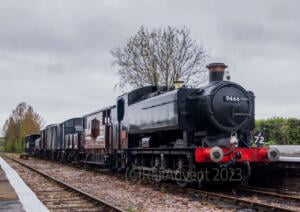This book is a biography of the great British engineering pioneers George and Robert Stephenson, who still have an influence on the world we live in, from being at the forefront of early railways to the cutting edge of modern engineering.
Published in September 2020, this hardback book from publishers Pen & Sword and written by Caroline Roope, measures around 15.88 cm x 25.4 cm, has 232 pages, and 50 black-and-white illustrations. It has a published price of £25, but can be obtained from Amazon for £19.08.
In 19 chapters, industrial historian Anthony Burton explains how the two Stephensons were responsible for the development of many early railways in both Britain and other parts of the world. Burton provides an insight into George and Robert’s lives and their ability to overcome some of the most-pressing engineering problems of their time.
The first challenge with this book is that George’s father and son were both called Robert, and both became engineers. However, the author has succeeded in maintaining the distinction between the two Roberts.
From the first chapter, which provides an account of the working conditions in the Tyneside collieries, it becomes clear that George was destined for a career in engineering when he designed a miners’ safety lamp to rival the now-universal Davy safety lamp. In chapter two, the author describes how George gained a thorough understanding of the workings of steam engines whilst working at Killingworth Colliery, which led to his and Robert’s career in engineering.
Throughout the book, the author doesn’t burden us with lots of technical details but provides a very readable description of the many outstanding examples of George and Robert’s works, such as building a steam engine and demonstrating it to the owners of Killingworth Colliery and showing them that it could be more profitable than horses.
Chapters 6 and 8 to 10 describe George’s challenges in building the Liverpool and Manchester Railway, and the competition to select a suitable locomotive that culminated in the Rainhill Trials. The competing locomotives, the trials themselves, and the evolution of Rocket are covered, as well as the railway’s opening in 1830, the success of which was assured by the performance of Rocket at the Trials and further improved locomotives built by Robert.
Chapter 7 is an interlude in the Liverpool and Manchester story as it describes the time Robert was away in South America setting up silver mines, and where he met Richard Trevithick and shared ideas about improving steam locomotives.
Chapter 13 shows how in 1823, George, along with others, established the first locomotive manufacturing works in Newcastle and appointed Robert as managing partner. The works were where the first engines for the Stockton and Darlington Railway were built.
In Chapter 14 the author tells how the Stephensons developed a relationship with George Hudson ‘The Railway King’, which, despite their obviously different ethical values, was a success, with Hudson promoting many railways that were engineered by the Stephensons.,
The last five chapters explain how George moved from railway construction to colliery ownership, whilst Robert was in increasing demand, as engineer-in-chief for the Chester & Holyhead and the York, Newcastle & Berwick Railways, both of which included massive bridges. In 1847, while a train was crossing the bridge across the River Dee at Chester, one of the iron spans collapsed with a loss of life. Robert, as chief engineer, was the principal witness at the inquest and technical enquiry. At the same time, he was designing the tubular spans for the Britannia Bridge across the Menai Strait and constructing the Newcastle High Level and Berwick Royal Border Bridges.
Robert was also involved in European projects, he became MP for Whitby, helped organise the Great Exhibition of 1851, where he was an enthusiastic supporter of the revolutionary design of glass panes in an elaborate wrought-iron frame that became known as The Crystal Palace. After his death. he received the same honour as Thomas Telford by being buried in Westminster Abbey.
The illustration below shows the Middleton colliery railway, which was the world’s first commercially successful steam railway and was where George Stephenson saw his first steam locomotive.

When Isambard Kingdom Brunel built his broad gauge line between London and Bristol his Great Western Railway’s Swindon Works had not been built, so his locomotives were ordered from elsewhere, such as North Star illustrated below which came from Stephenson’s Newcastle works.

It is doubtful if Robert Stephenson could get away today with what he did in building the original York station when he arranged for an archway to be cut right through the ancient city walls to accommodate the railway.

Among the many bridges that Robert Stephenson built was the high-level bridge across the Tyne at Newcastle which is seen in the photograph below taken a century ago with a steam train visible on the upper level.

Robert Stephenson’s prowess as a railway engineer saw him in demand in Europe, including Norway, as seen in the illustration below that shows the inaugural run of the country’s first steam railway.

The book is available to purchase from Amazon and Pen & Sword.
We would like to thank Pen & Sword for providing RailAdvent with a copy of the book for review.






Responses